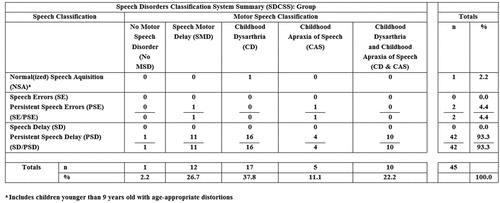Figures & data
Table 1. Estimates of the interjudge and intrajudge agreement for phonetic transcription, prosody-voice coding, and acoustic analyses.
Table 2. Description of 45 participants with Down syndrome.
Figure 1. Estimates of the prevalence of speech and motor speech disorders in adolescents with Down syndrome.

Figure 2. Estimates of the prevalence of five subtypes of dysarthria in adolescents with Down syndrome. The solid filled bars in Figure 2a are the mean percentage score findings for the 27 participants on the five dysarthria subtype indices described in the Supplement. The diagonal filled bars in Figure 2b are the mean percentile score findings for the same speakers on the five indices.

Table A1. The five Speech classifications and five Motor Speech classifications in the SDCS are each mutually exclusive. The five dysarthria subtype classifications are not mutually exclusive. That is, a speaker can meet percentile criteria for more than one of the five listed dysarthria subtype classifications (i.e., mixed dysarthria). See Supplement for the procedures and measures used to classify each motor speech disorder.
